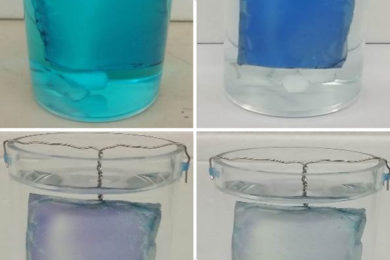A polymer mat developed at Rice University has the ability to fish biologically harmful contaminants from water through a strategy known as “bait, hook and destroy.” Tests with waste water showed the mat can efficiently remove targeted pollutants, in this case a pair of biologically harmful endocrine disruptors, using a fraction of the energy required by other technology. The technique can also be used to treat drinking water.
The mat was developed by scientists with the Rice-led Nanotechnology-Enabled Water Treatment (NEWT) Center. The research is available online in the American Chemical Society journal Environmental Science and Technology.
The Rice University-led NEWT Center created a nanoparticle-infused polymer mat that both attracts and destroys pollutants in wastewater or drinking water. A mat, top left, is immersed in water with methylene blue as a contaminant. The contaminant is then absorbed at top right by the mat and, in the bottom images, destroyed by exposure to light. The mat is then ready for reuse. (Credit: Rice University/NEWT)
The mat depends on the ability of a common material, titanium dioxide, to capture pollutants and, upon exposure to light, degrade them through oxidation into harmless byproducts.
Titanium dioxide is already used in some wastewater treatment systems. It is usually turned into a slurry, combined with waste water and exposed to ultraviolet light to destroy contaminants. The slurry must then be filtered from the water.
The NEWT mat simplifies the process. The mat is made of spun polyvinyl fibres. The researchers made it highly porous by adding small plastic beads that were later dissolved with chemicals. The pores offer plenty of surface area for titanium oxide particles to inhabit and await their prey.
The mat’s hydrophobic fibres naturally attract hydrophobic contaminants like the endocrine disruptors used in the tests. Once bound to the mat, exposure to light activates the photocatalytic titanium dioxide, which produces reactive oxygen species (ROS) that destroy the contaminants.










